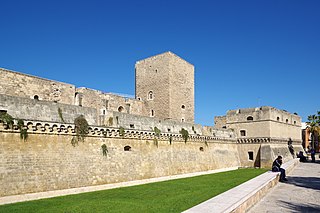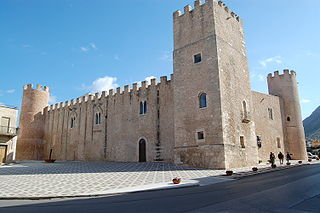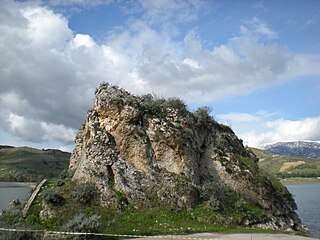Related Research Articles

Alessandria della Rocca is a comune and small agricultural town located in the northern part of the Province of Agrigento, west central Sicily, southern Italy.

Castello Ursino, also known as Castello Svevo di Catania, is a castle in Catania, Sicily, southern Italy. It was built in the 13th century as a royal castle of the Kingdom of Sicily, and is mostly known for its role in the Sicilian Vespers, when it became the seat of the Sicilian Parliament. The castle is in good condition today, and it is open to the public as a museum.

Celano is a town and comune in the Province of L'Aquila, central Italy, 120 km (75 mi) east of Rome by rail.

Aci Castello is a comune in the Metropolitan City of Catania in Sicily, Italy. Located 9 kilometres (6 mi) north of Catania on the Mediterranean coast, the city's primary economic sectors are agriculture and industry. The city is surrounded by Aci Catena, Acireale, Catania, San Gregorio di Catania and Valverde.

Misilmeri is a town and comune in the Metropolitan City of Palermo, Sicily. It is approximately 15 kilometres (9 mi) from Palermo and its name means "the resting place or the messuage of the Emir", and dates from the Muslim emirate of Sicily. The village rose around a castle founded by emir Jafar II (998–1019). In 1068 the Battle of Misilmeri was fought between the Normans and Arabs

Castronovo di Sicilia is a comune (municipality) in the Metropolitan City of Palermo in the Italian region Sicily, located about 50 kilometres (31 mi) southeast of Palermo.

Duke of Carcaci is a title in the Kingdom of Sicily, held by the head of one branch of the House of Paternò, a major Sicilian noble family.

The Castello di Lombardia is a castle in Enna, Sicily. It is one of the largest and most ancient edifices in Italy, with an area of some 26,000 m2 (280,000 sq ft)

The Castello di Milazzo is a castle and citadel in Milazzo, Sicily. It is located on the summit of a hill overlooking the town, on a site first fortified in the Neolithic era. The Greeks modified it into an acropolis, and it was later enlarged into a castrum by the Romans and Byzantines. The Normans built a castle, which was further modified and enlarged during the Medieval and Early Modern periods. It is now in good condition, and open to the public.

The Castello Normanno-Svevo or Norman-Swabian Castle, also known as the u Castídde in the Barese dialect, is a castle in the Apulian city of Bari, Italy.

The Castello Normanno, or alternatively the Castello di Aci, is a castle in Aci Castello in the Metropolitan City of Catania in Sicily, southern Italy. The castle is situated on a rocky outcrop jutting out into the sea. Its precise date of construction is uncertain, but it was important to the development of its region during the Middle Ages. During the War of the Sicilian Vespers, it was subject to Roger of Lauria. It was besieged more than once, and was briefly controlled by the Spanish. It is currently a museum.

The Calatubo Castle is a fortress located near the town of Alcamo, Sicily, southern Italy.

The Castello di Caccamo is a castle in Caccamo, Sicily. It is among the largest and best preserved Norman castles in Sicily, and one of the largest in Italy.

The Castle of the Counts of Modica is a medieval castle situated in the town centre of Alcamo, in the province of Trapani, Sicily, southern Italy.

The fortifications of Messina were a series of defensive walls and other fortifications which surrounded the city of Messina, Sicily. The first walls were built during the Middle Ages in around 1200. A system of bastioned fortifications was constructed around the city in the 1530s and 1540s. The fortifications were modified over the years, with the last major addition being the Real Cittadella, which was built in the 1680s. Most of the walls were demolished in the 19th and 20th centuries, but some parts of the walls still survive today.

The Castello di Terra is a castle in Trapani, Sicily. It was originally built in the late 12th century, and was modified over the years until the 19th century. The castle is now in ruins.
The Castello di Barrugeri, also known as Birigirum, was a castle in Aragona, Sicily. It was built in around 1295.

The Castello di Bivona was a castle in the town of Bivona, Sicily. It was built in the 14th century, and it was partially destroyed when it was sacked in 1529. The castle is now in ruins, and a few remains can still be seen.

The Castello della Pietra d'Amico was a 14th-century castle in Alessandria della Rocca, Sicily, southern Italy. Today, very little remains of the structure, since part of the rock on which it was built collapsed.
References
- ↑ Cimino, Francesco. "Castello Di Bifar". iCastelli.it (in Italian). Archived from the original on 4 September 2015. Retrieved 22 August 2015.